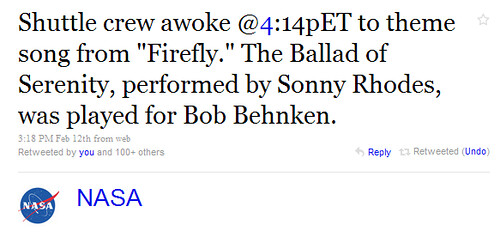Sometimes there’s a visible gulf between geekdom and academia, despite the stereotype of these two realms being congruent. I am reminded of this gulf by this odd story about a paper by William Edelstein, a senior and distinguished physicist (in my own field of MRI research), who has calculated the lethality of interstellar travel:
Interstellar space is an empty place. For every cubic centimetre, there are fewer than two hydrogen atoms, on average, compared with 30 billion billion atoms of air here on Earth. But according to William Edelstein of the Johns Hopkins University School of Medicine in Baltimore, Maryland, that sparse interstellar gas should worry the crew of a spaceship travelling close to the speed of light even more than the Borg decloaking off the starboard bow.
Special relativity describes how space and time are distorted for observers travelling at different speeds. For the crew of a spacecraft ramping up to light speed, interstellar space would appear highly compressed, thereby increasing the number of hydrogen atoms hitting the craft.
Worse is that the atoms’ kinetic energy also increases. For a crew to make the 50,000-light-year journey to the centre of the Milky Way within 10 years, they would have to travel at 99.999998 per cent the speed of light. At these speeds, hydrogen atoms would seem to reach a staggering 7 teraelectron volts – the same energy that protons will eventually reach in the Large Hadron Collider when it runs at full throttle. “For the crew, it would be like standing in front of the LHC beam,” says Edelstein.
The spacecraft’s hull would provide little protection. Edelstein calculates that a 10-centimetre-thick layer of aluminium would absorb less than 1 per cent of the energy. Because hydrogen atoms have a proton for a nucleus, this leaves the crew exposed to dangerous ionising radiation that breaks chemical bonds and damages DNA. “Hydrogen atoms are unavoidable space mines,” says Edelstein.
The fatal dose of radiation for a human is 6 sieverts. Edelstein’s calculations show that the crew would receive a radiation dose of more than 10,000 sieverts within a second. Intense radiation would also weaken the structure of the spacecraft and damage its electronic instruments.
All well and good and I have no reason to doubt Dr. Edelstein’s calculations (we medical physics types do have a professional interest in radiation dose and shielding, after all). But clearly Dr. Edelstein is not a fan of Star Trek, because even the most newbie of Trekkies knows about the Navigational Deflector Array. In addition, Starfleet vessels also have Bussard Collectors on the warp nacelles, which are the sci-fi-ified version of the Bussard ramjet.
My point is, physics geeks and sci fi geeks clearly aren’t as overlapping sets as I had assumed. But where a medical physicist might see errant hydrogen atoms as dose, a different kind of physicist might see them as fuel. In a way we scientists do bring our own biases to the table…
